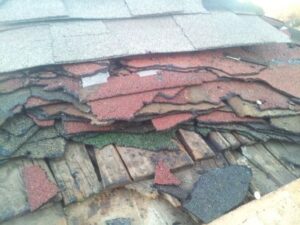How to install a cheap roof. (Not the same as saving money on a roof!)
There’s inexpensive. And then there’s cheap. Inexpensive implies low price with a value at least equal to the cost. Cheap implies shoddiness, inferiority, and unworthiness. Cheap tends to show up everywhere around us: home electronics, clothing, generic food. The construction industry is not exempt by any means. And roofing can often lead the way because unfortunately, a lot of property owners just don’t know enough about roofing to know when they’re being sold something cheap vs getting good quality at an affordable price. So, let’s take a look at a few things that some contractors do to install a cheap roof.
Install “discount” shingles
Shingles are the most common roof covering here in North Texas. And there are a lot of places to purchase them. Reputable roofing contractors typically purchase shingles and other roofing supplies from industry supply houses such as ABC Supply, or from home improvement retailers like Lowe’s through their contractor programs. But there are also other smaller roofing suppliers that sell shingles. Some of these suppliers sell good quality products just like the big companies do. But some sell deeply discounted shingles. These shingles often are contractor leftovers from jobs or factory seconds. These will often have slight color differences from one package to the next because of varying production dates. Or they may have slight defects not noticeable to the average consumer. Either way, these shingles are generally void of any warranty.
Install builder grade accessories
The term “builder grade” sounds like it would reference quality components that have been vetted by builders and contractors. But it’s actually evolved to refer to the cheapest quality and lowest cost products that a builder can install just to get a project completed. In roofing, this can be things like plastic pipe boots (instead of lead or high-grade rubber), asphalt sealant (instead of silicone or urethane), staples (instead of galvanized nails), plastic passive ventilation (instead of turbines, power vents or ridge vents), or any of a number of other items. These low-grade components will usually perform the same function as more expensive components but can be expected to fail prematurely or underperform in the first place. Installing builder grade components is a sure-fire way to get to pay for them again far too soon.
Reuse old materials
On a typical shingle roof replacement job, the shingles account for about 2/3 of the cost of the materials. The rest of the cost comes from nails, flashings, underlayments and other accessories like caulk or paint. One way to keep a roof cheap (not inexpensive) is to reuse as many of the old materials as possible. Underlayment, also often called felt paper, can get reused- even if it’s torn or becoming brittle- without installing new underlayment. Pipe boot flashings and drip edge flashings get reused too. Taking these kinds of shortcuts takes a big risk. Relying on these older components to last the life of the new roof without failing, after having already survived the life of the previous roof, is asking for trouble.
Don’t tear off the old roof
It used to be pretty common practice to not tear off a roof before installing. And it is still occasionally done. We usually run into at least a couple roofs each year that have multiple layers. So, what is to gain by leaving the old shingles? It’s the cost of removing and properly disposing of the old shingles. This could save a homeowner a few hundred or even a thousand dollars or more on a typical roof job. But what is the downside? Having multiple layers adds weight to the roof that the framing is not designed to handle. This can lead to sagging and broken decking and framing, cracked drywall, and other problems. Because of that, most municipalities now will not allow more than 2 layers of shingles on a roof. Another downside to not removing an old roof is that it doesn’t allow for inspecting the roof decking that supports the shingles. Often, especially if there has ever been a leak, the decking can have weak or rotten spots. And on older homes the decking may not even meet current building codes.
Use cheap labor
Roofing is hard work! If you don’t believe that, spend 10 minutes watching a crew the next time you see a roof being replaced. But beyond the physical aspect, roofing requires skill. And just like anything else, the contractors that have the experience and skills to offer superior service are often compensated accordingly. Conversely, cheaper prices may reflect a lower skill set. Also, cheaper labor can often lead to cutting corners on details to save time. And labor may be cheap because they haven’t invested in quality tools to perform their work. In addition, don’t expect a quality warranty from cheap labor. Quality roofing contractors will frequently provide warranties of 2, 5 or even 10 years for certain roofing jobs. Cheap labor will likely have very limited or practically no warranty. And if there is a problem, getting the cheap contractor to come back and address a problem can be a huge challenge.
Do you have to spend a lot more to get a good roof?
Roofing is one of those things that you often get exactly what you pay for. But just because you want to save a little doesn’t mean you have to go cheap. Do your homework and research the products you are interested in. Ask your contractor about their installation practices and the quality of their components. If something sounds a little off, keep asking more questions or ask another contractor their opinion. And remember, there’s inexpensive, and then there’s cheap.
Want to learn more? Take a look at these other articles:
Do I have to pay my deductible on my insurance claim?



